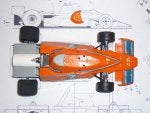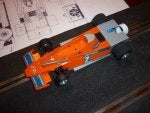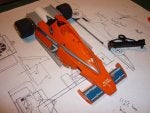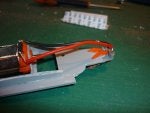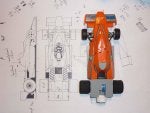So as those following my stalled Vanwall build will already know I'm off on another project without of course finishing the first......
I got to thinking after another of those frustrating race nights (with folk who actually buy modern competition cars and practice (for hours and hours) as drivers) where I always seem to come last.........
What I need to do is build a car (an F1 of course as that's my thing) which will have a clearly unfair advantage so I can go faster!
So I thought well there was that car that was deemed legal just for that one Swedish GP - the Brabham BT46B. As most will know there was a big fan in the back and a skirt around the bottom so it literally sucked down onto the road.
like this....
![]()
it just happened that I finally got one of the Spanish Scalextric BT46's and I found some drawings and hey, with some thining and lowering its not bad.
so I did some drawings.......
and then I started building........
![]()
![]()
The real problem seems to be that with slot cars there's, ...... well, a SLOT, so I'm never gonna get the suck I really need. I had ideas about making two skirted zones one under each side pod, hoping that provided the car didn't slide too far (it shouldn't as it'll be sucking!) adhesion should be better.
Then I thought, heck the speed, power and aerodynamics at 1/32 just aren't like the real thing so maybe the fan will overcome the slot problem.
So I'm just going to build it and see what heppens. This is where I am now....
![]()
Question - anyone know where I can get a 14mm diameter fan / propeller / axial impeller from???????????
I'll update as it evolves (and it'll be quicker than the vanwall which I WILL finish afterwards)!
Andi
I got to thinking after another of those frustrating race nights (with folk who actually buy modern competition cars and practice (for hours and hours) as drivers) where I always seem to come last.........
What I need to do is build a car (an F1 of course as that's my thing) which will have a clearly unfair advantage so I can go faster!
So I thought well there was that car that was deemed legal just for that one Swedish GP - the Brabham BT46B. As most will know there was a big fan in the back and a skirt around the bottom so it literally sucked down onto the road.
like this....

it just happened that I finally got one of the Spanish Scalextric BT46's and I found some drawings and hey, with some thining and lowering its not bad.
so I did some drawings.......
and then I started building........


The real problem seems to be that with slot cars there's, ...... well, a SLOT, so I'm never gonna get the suck I really need. I had ideas about making two skirted zones one under each side pod, hoping that provided the car didn't slide too far (it shouldn't as it'll be sucking!) adhesion should be better.
Then I thought, heck the speed, power and aerodynamics at 1/32 just aren't like the real thing so maybe the fan will overcome the slot problem.
So I'm just going to build it and see what heppens. This is where I am now....

Question - anyone know where I can get a 14mm diameter fan / propeller / axial impeller from???????????
I'll update as it evolves (and it'll be quicker than the vanwall which I WILL finish afterwards)!
Andi




